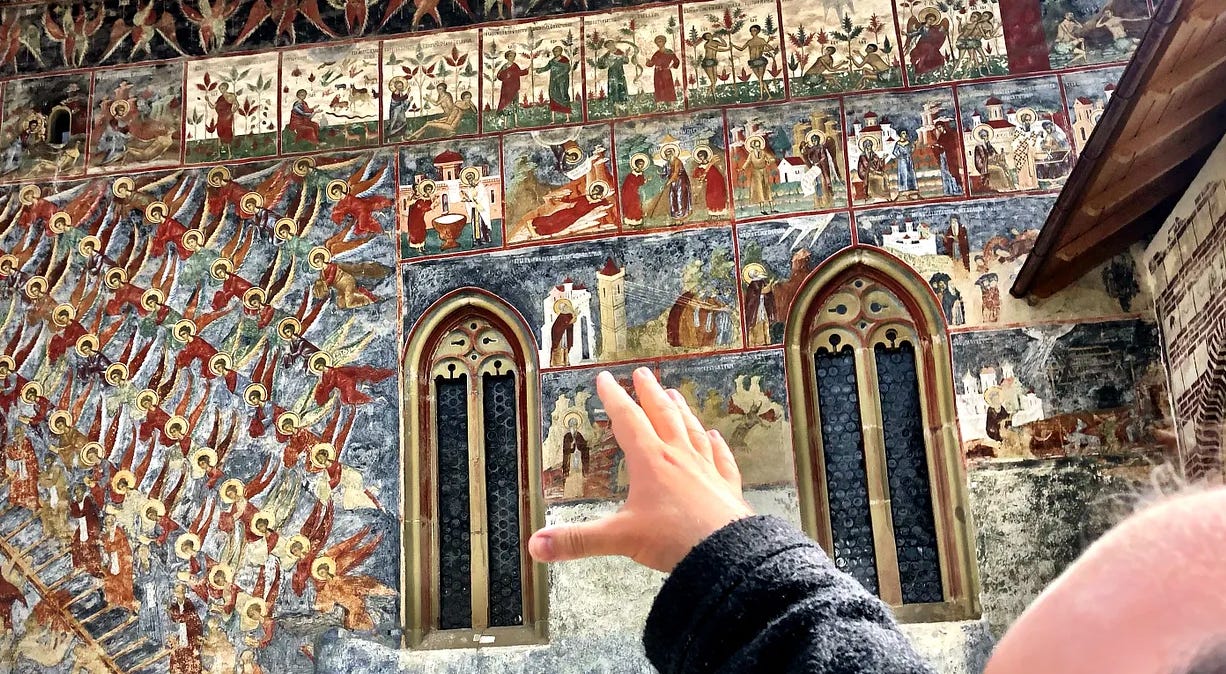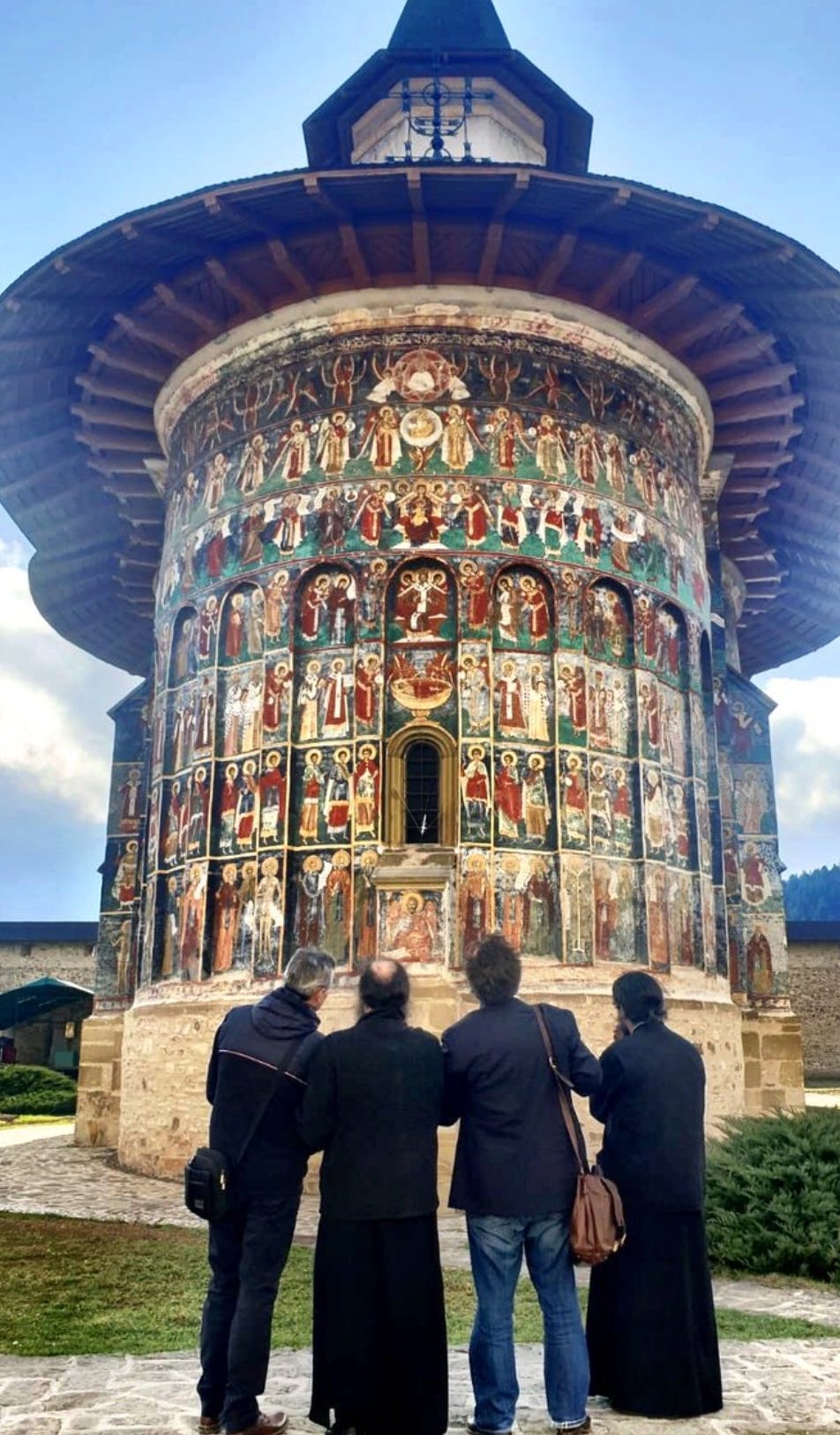Painting With Fingers Of Fire
From 'Living In Wonder', Visiting A Painted Medieval Romanian Church
From the Living In Wonder chapter on Beauty:
One cool spring day, I stood outside the sixteenth-century Orthodox women’s monastery of Sucevița. A few miles away, a country was at war, but behind the monastery walls, God manifests in lines and colors the vividness of which seem undimmed by the passage of time. Sucevița is one of the eight famed painted churches of Moldavia, which have been declared UNESCO World Heritage sites. Catholics have the Gothic cathedrals of northern France as peerless architectural expressions of their faith; the Orthodox have the painted churches of Moldavia.
The interior walls of the churches are covered in religious frescoes, as most Orthodox churches are. What sets these apart is that the exterior walls are also glowing with iconographic frescoes. There are no others like them anywhere in the world. They look as if they descended from heaven.
“This is Jacob’s ladder,” said Father Chrysostom, the bald, bushy-bearded monk accompanying me. A large image of the ladder ascending to paradise covered most of the wall, with legions of angels with golden halos helping the saved make their way upward to God. The song I learned in Methodist Sunday school came to mind:
We are climbing Jacob’s ladder,
We are climbing Jacob’s ladder,
We are climbing Jacob’s ladder,
Soldiers of the cross.
The glory of this image almost paralyzed me. Imagine what it must have looked like to generations of dirt-poor Romanian peasants, the comfort it gave them and the dignity to which it raised them by teaching them that the stories told on these walls were also their own.
Father Chrysostom drew my attention to a series of images running along the top of the church wall: Adam and Eve in the garden of Eden, standing in cream-colored light. The brightness, the monk told me, signifies that this is how humanity lived before the fall: surrounded by divine light. Father Chrysostom led my eye rightward, to the panels with no more light, which show Adam and Eve in the darkness of sin. Adam is wearing a garment of red, while Eve is clothed in green.
“We can see that the key to the meaning of all of creation is becoming one with God, through the Holy Spirit,” my guide said. “That’s why you can see all the red present. We see this green as the meaning of the biological life, and this red as the image of the mystical life. It’s life beyond life—it’s more than life. And you see them together. There is a reason behind biological life, the Logos. Pentecost had to do with all of creation.”
The monk directed me to look more deeply. These aren’t colors and images that someone merely found aesthetically pleasing. As with the carvings decorating the Chartres Cathedral, they have profound meaning. Every inch of this late medieval Romanian church is a catechism meant to teach worshipers the stories that tell them who they are and how the cosmos exists. It is an encyclopedia written in pigment.
To step inside the little church is like entering a dreamworld. There are biblical stories painted everywhere, in colors so intense you can almost taste them. The figurative style is austerely Byzantine, in the Orthodox tradition, but the strong lines are dams barely holding back surging seas of glowing color, of the energy of life. Is this what reality looks like below the surface of things? The Christ manifested here, the Virgin, the saints, the seraphim and cherubim, the archangels—they feel more alive than I do. You don’t have to work to feel the presence of God here. The hands of God-loving artists have done all the labor for you. All you have to do is receive it and allow wonder to overtake you.
“You have talked about the re-enchantment of the world,” said Father Chrysostom. “We can do it by telling stories. Like Tolkien did it, you know? Like C. S. Lewis did it.”
Father Lucian, a young priest walking with us, added, “They reinvented how to tell the Story for the current generation. What Tolkien and Lewis had was art and craftsmanship with theological depth. If you can find a way to bring art and craftsmanship with theological depth, you have something quite powerful.”
We left the church’s lambent interior and moved along the back wall. At the bottom of the visual hierarchy, there was a row of elderly men wearing crowns, but without halos. These are the pre-Christian Greek philosophers, said the monk, shown here because they were the first to identify the logos and to prepare the way for Christ, the divine Logos. It is all part of the Story—the Story of stories, the narrative of which all of us believers are a part. I had all of this clear in my head from reading in theology. But to see it encoded in painting of unsurpassed vividness impressed these truths on my imagination in ways that no paragraphs ever could.
Father led me to the grass surrounding the exterior of the east-facing sanctuary part of the church. The altar, the holy of holies, is on the other side of the round stone veil. Here on the outside, the monk pointed to the top of the central pillar bisecting the semicircular sanctuary.
“Look from top to bottom,” he instructed. “This tells the story of God reaching down to call us to himself. These are the various embodiments of the Logos.”
At the very top there is God as the Ancient of Days, a title used by the prophet Daniel. “I beheld till the thrones were cast down, and the Ancient of days did sit, whose garment was white as snow, and the hair of his head like the pure wool” (Dan. 7:9 KJV). It conveys the sense of God in eternal perfection. The Ancient of Days sits inside an eight-pointed image, symbolizing the six days of creation, the seventh day of rest, and the eighth day standing for eternity and the cycle of time. This is a symbol of all creation.
My eye descended, and I saw Christ Emmanuel, the divine Logos among the archangels, the ones who first saw him (remember, it was the archangel Gabriel who brought news of the Messiah to Mary, who announced that she would call the babe “Emmanuel”—God with us). Below that, the Christ child, and under that, Christ in glory as the Emperor of all. And beneath that icon is one of Christ in the Eucharist.
Then, at the level of the window that brings light to the altar, I saw images of holy martyrs, who gave their lives to testify to the truth of the Light of the World. At the bottom of the ladder of images are monks, symbolizing the prophetic voice of the church, and at the center, painted on a buttress, is John the Baptist, the forerunner of the Lord, who proclaimed all of this to the world.
Here, like Jacob’s ladder on the side wall of the church, is another ladder linking heaven to earth, and eternity to our mortal lives. This stunning vertical row of holy images shows us how God revealed himself to us. Said the monk, “We can climb the ladder only because the Logos chose to come down to us. We can do nothing without Christ.”
The tour of the painted medieval church taught me nothing I didn’t already know as a matter of theology. What it did was to make the familiar stories and theological principles live in a fresh and intense way in my imagination. Standing in front of the frescoes, painted with fingers of fire, I felt somehow drawn into them, as if I were crossing a border into another realm, into a story that was already my own, but that I was right here, right now, being invited to live out the truth of Christ more fully. It was an incredible feeling, one I will never forget.
Living In Wonder will be in bookstores on October 22 in the US, on October 24 in the UK. US buyers pre-order here. UK buyers can pre-order here. If you are in the US and want a signed copy, pre-order exclusively from Eighth Day Books. And if you want to come to the book launch event in Birmingham, Alabama, on October 21 (for which you need to register at that link), Eighth Day will be on hand to sell copies, which I will cheerfully sign. (Note well, Paul Kingsnorth will be there too, so bring your PK books to get signed, or buy one or more from Eighth Day.)
Keep reading with a 7-day free trial
Subscribe to Rod Dreher's Diary to keep reading this post and get 7 days of free access to the full post archives.







